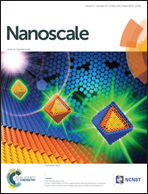Gold nanocluster sensitized TiO2 nanotube arrays for visible-light driven photoelectrocatalytic removal of antibiotic tetracycline†
Abstract
It is of technical interest to develop low-cost, high-quality and scalable photosensitizers that could efficiently harvest visible light. Here we design an efficient photoelectrocatalyst by integrating a recently developed gold nanocluster (AuNC, as a photosensitizer) into two types of highly ordered TiO2 nanotube arrays (TNAs, as substrates to host the photosensitizers). The TNA electrodes used in this study are a short TNA (∼0.5 µm in length, synthesized by the anodic oxidation in an aqueous hydrofluoric (HF) acid solution) and a long TNA (∼4.5 µm in length, synthesized by the anodic oxidation in a fluorinated ethylene glycol (EG) solution). A number of characterization techniques (e.g., FESEM, XRD and XPS) were applied to study the as-synthesized nanocomposites. In particular, diffuse reflectance spectroscopy and photochemical measurements suggest that the AuNC-coated TNA electrodes have successfully extended visible light absorption and improved their photochemical performance. Compared with the blank TNAs, the as-designed nanocomposites exhibit an evidently enhanced photoelectrocatalytic performance towards tetracycline (an emerging antibiotic contaminant in aquatic environment) decomposition, where the removal efficiency increases from 65% to 81% for AuNC/long-TNA and from 46% to 73% for AuNC/short-TNA electrodes, respectively. The improved performance is largely attributed to the photo-electro-chemical synergetic effect. The photochemical performance of the as-designed nanocomposites could be further improved by fine tuning the size, composition, and surface of the AuNC-based photosensitizers.


 Please wait while we load your content...
Please wait while we load your content...